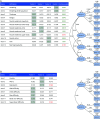Measurement Properties of 2 Novel PROs, the Pompe Disease Symptom Scale and Pompe Disease Impact Scale, in the COMET Study
- PMID: 37559825
- PMCID: PMC10409572
- DOI: 10.1212/CPJ.0000000000200181
Measurement Properties of 2 Novel PROs, the Pompe Disease Symptom Scale and Pompe Disease Impact Scale, in the COMET Study
Abstract
Background and objectives: The Pompe Disease Symptom Scale (PDSS) and Impact Scale (PDIS) were created to measure the severity of symptoms and functional limitations experienced by patients with late-onset Pompe disease (LOPD). The objectives of this analysis were to establish a scoring algorithm and to examine the reliability, validity, and responsiveness of the measures using data from the COMET clinical trial.
Methods: The COMET trial was a randomized, double-blind study comparing the efficacy and safety of avalglucosidase alfa and alglucosidase alfa in patients with LOPD aged 16-78 years at baseline. Adult participants (18 years or older) completed the PDSS and PDIS daily for 14 days at baseline and for 2 weeks before quarterly clinic visits for 1 year after randomization using an electronic diary. Data were pooled across treatment groups for the current analyses. Factor analysis and inter-item correlations were used to derive a scoring algorithm. Test-retest and internal consistency analyses examined the reliability of the measures. Correlations with criterion measures were used to evaluate validity and sensitivity to change. Anchor and distribution-based analyses were conducted to estimate thresholds for meaningful change.
Results: Five multi-item domain scores were derived from the PDSS (Shortness of Breath, Overall Fatigue, Fatigue/Pain, Upper Extremity Weakness, Pain) and 2 from the PDIS (Mood, Difficulty Performing Activities). Internal consistency (Cronbach α > 0.90) and test-retest reliability (intraclass correlation >0.60) of the scores were supported. Cross-sectional and longitudinal correlations with the criterion measures generally supported the validity of the scores (r > 0.40). Within-patient meaningful change estimates ranging from 1.0 to 1.5 points were generated for the PDSS and PDIS domain scores.
Discussion: The PDSS and PDIS are reliable and valid measures of LOPD symptoms and functional impacts. The measures can be used to evaluate burden of LOPD and effects of treatments in clinical trials, observational research, and clinical practice.
Trial registration information: ClinicalTrials.gov identifier: NCT02782741.
Copyright © 2023 The Author(s). Published by Wolters Kluwer Health, Inc. on behalf of the American Academy of Neurology.
Conflict of interest statement
M.M. Dimachkie has received consulting fees from Abata/Third Rock, Abcuro, Amazentis, ArgenX, Astellas, Catalyst, Cello, Covance/Labcorp, CSL-Behring, EcoR1, Janssen, Kezar, MDA, Medlink, Momenta, NuFactor, Octapharma, Priovant, RaPharma/UCB, Roivant Sciences Inc, Sanofi, Scholar Rock, Shire Takeda, Spark Therapeutics, TACT, UCB Biopharma, and UpToDate. M.M. Dimachkie has undertaken contracted research for or received unrestricted educational grants from Alexion, Alnylam Pharmaceuticals, Amicus, Biomarin, Bristol-Myers Squibb, Catalyst, Corbus, CSL-Behring, FDA/OOPD, GlaxoSmithKline, Genentech, Grifols, Kezar, Mitsubishi Tanabe Pharma, MDA, NIH, Novartis, Octapharma, Orphazyme, Ra Pharma/UCB, Sanofi, Sarepta Therapeutics, Shire Takeda, Spark Therapeutics, The Myositis Association, TMA, UCB Biopharma/RaPharma, and Viromed/Healixmith. P.S. Kishnani has received research/grant support from Sanofi and Amicus Therapeutics and has received consulting fees and honoraria from Sanofi, Amicus Therapeutics, Maze Therapeutics, JCR Pharmaceutical, and Asklepios Biopharmaceutical, Inc. (AskBio). P.S. Kishnani is a member of the Pompe and Gaucher Disease Registry Advisory Boards for Sanofi, Amicus Therapeutics, and Baebies. P.S. Kishnani has equity in Asklepios Biopharmaceutical, Inc. (AskBio), and Maze Therapeutics. C. Ivanescu is an employee of IQVIA. G. Flore was an employee of IQVIA at the time of study participation. C. Gwaltney has received consulting fees from Sanofi. N.A.M.E. van der Beek has received consulting fees and travel reimbursement from Sanofi and Amicus Therapeutics. A. Hamed is an employee of Sanofi. K. An Haack and her spouse are employees of Sanofi. L. Pollissard is an employee of Sanofi. E. Baranowski was an employee of Sanofi at the time of study participation. S.E. Sparks is an employee of Sanofi. P. DasMahapatra is an employee of Sanofi. Full disclosure form information provided by the authors is available with the full text of this article at Neurology.org/cp.
Figures



References
-
- Reuser A, Hirschhorn R, Kroos M. Part 16: Lysosomal disorders: Pompe disease: glycogen storage disease Type II, acid α-glucosidase (acid Maltase) deficiency. In: Valle D, Antonarakis S, Ballabio A, Beaudet A, Mitchell G, eds. OMMBID – The Online Metabolic and Molecular Bases of Inherited Diseases. McGraw-Hill Education, 2019.
Associated data
LinkOut - more resources
Full Text Sources
Medical
Miscellaneous
